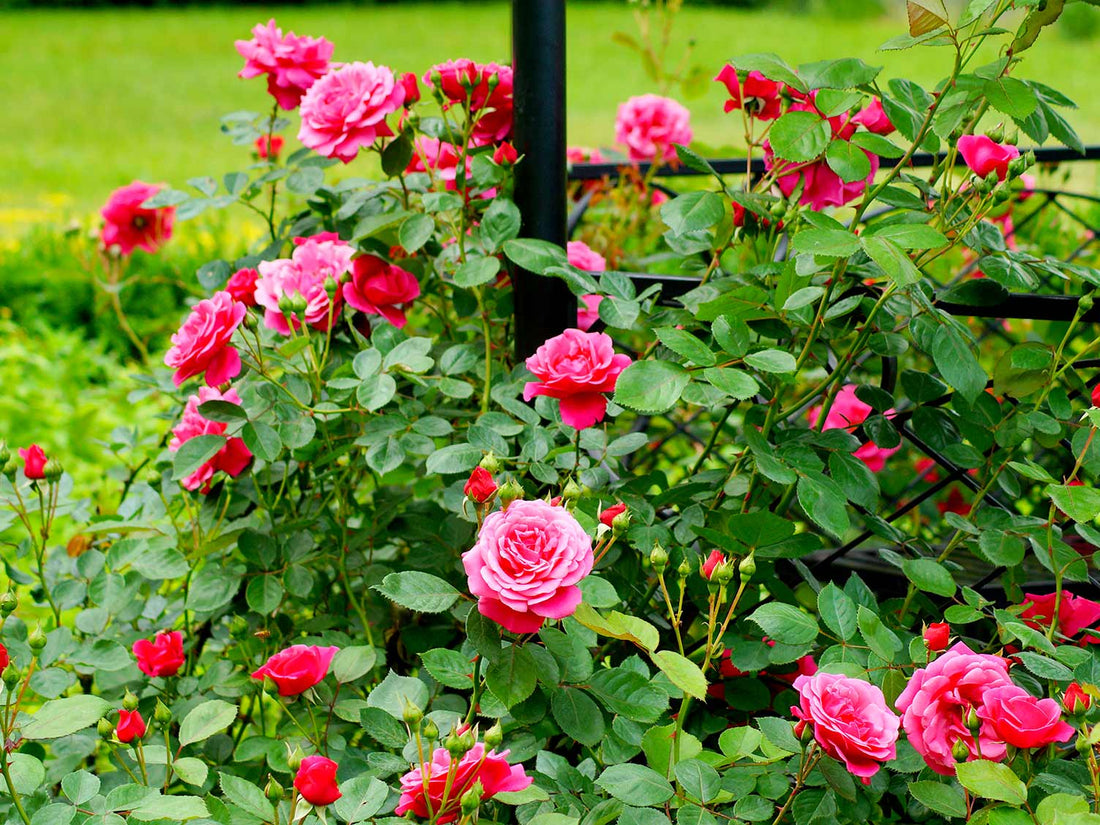Why are roses pruned ?
- To promote growth of new wood which will bear flowers – rejuvenation.
- To remove dead, diseased or damaged material.
- For aesthetic appearance – shaping.
- To allow light and air circulation into the centre of the plant for bud
development. Light improves flower colour and air circulation reduces fungal infection. - To control growth for ease of spraying and cutting flowers.
- To improve the size and quality of flowers.
When to prune
Some summer pruning of roses is carried out, and this is to promote
continuing flower production. Summer pruning is really limited to clipping
off dead flower heads and the correct method for doing so is covered under
the heading of ‘How to Prune’.
Winter pruning in Canberra is usually done in August but in warmer areas
it is done earlier. In Canberra, if roses are pruned back too hard and a late severe frost occurs then there will not be any further buds left to cut back to, so in this climate it is best not to prune too hard. If the plant is only taken back by
about half the height and does receive frost damage, then it is possible
to prune lower, to the next bud.
Pruning equipment
- Good quality secateurs which are sharpened and maintained regularly
- Pruning saw for removal of dead wood
- Loppers for removal of large branches
- It is also a good idea to have bleach or methylated spirits to clean the tools before moving onto the next plant. This helps to stop the spread of disease.
How to prune
When pruning always use a slightly angled cut and position the cutting edge
of the secateurs against the piece which is to be retained. The crunching
blade is against the piece to be cut off and discarded.
All cuts should be angled to avoid moisture remaining on the cut surface.
Remove any deadwood from the plant. Roses flower on current seasons wood so old unproductive wood should also be removed where possible.
Strong, thick, new wood must be retained but small, narrow, twiggy pieces
should be removed. Cut the strong canes of new wood back by about half, to an outward facing bud. It is best to leave about 4 or 5 strong canes on each plant if possible.
Remove any suckers which are growing from below the graft as these will
be from the rootstock. Do not remove any watershoots as these form the new productive wood of the plant.
For summer pruning, the spent flower is removed by cutting back to the nearest compound leaf with 5 leaflets, and a strong bud.
General hygiene
It is important to maintain good garden hygiene in areas where roses are
growing as they are prone to fungal diseases.
- Sterilise pruning equipment after pruning each plant so diseases are not
- transferred from plant to plant.
- Trim off any old leaves remaining on the plant after pruning and remove them.
- Pick up any fallen leaves or leaf litter and dispose of them. It is best not to compost this material.
- Spray with lime sulphur after pruning to rid the area of overwintering pests, eggs or fungal spores.
Ongoing maintenance
During the spring and summer months when roses are flowering, keep a close watch for aphids, scale and fungal disease and control these as quickly as possible to minimise damage.
Aphids can be sprayed with soap solution or pyrethrum. White oil will overcome any scale problems and black spot or powdery mildew can be controlled
by using a product such as Triforene or similar. Powdery mildew is often an indication that the plants are not receiving sufficient sun so it may be necessary to prune larger plants in the area to remedy this.
It is best to water roses with a dripper system or similar so that water is not splashed onto the leaves as this encourages fungal problems. A good thick mulch or ground cover will help to keep the roots cool and reduce weeds. Fertilise roses with a complete fertiliser in October and again in late March, or you can use a mixture of 5 parts of blood and bone to one part sulphate of potash.
Propagating roses
Cuttings are usually taken when winter pruning is done and should be at least
pencil thickness and of about 6”to 8” in length. Each piece of material should contain some buds and be healthy and free of disease. The
top of each piece should be cut on an angle. Cuttings are then
tied into bundles of about 10 pieces, tied with cord and placed into a
mixture of 1 part sand to 2 parts peat, at a depth of about half way. Some
moisture is needed but not too much, they should be kept damp, but not
wet. Callus will form by about November and the cuttings can be
separated and potted then. They can be left longer if necessary.
Ann Costelloe

